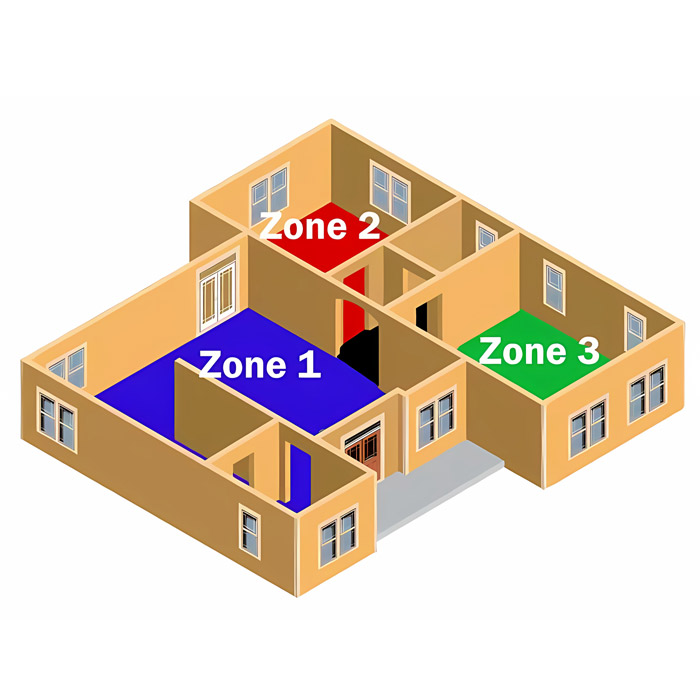
As homeowners and businesses strive for more efficient and customizable cooling solutions, the concept of zoned air conditioning has gained significant traction. One of the most effective ways to achieve this is through a ductless air conditioning system, also known as a ductless mini-split system. Here are some ways that a ductless HVAC system can be used to create zoned air conditioning, the benefits of such a setup, and why it might be the ideal solution for your cooling needs.
What is a Ductless Air Conditioning System?
A ductless air conditioning system consists of two main components: an outdoor unit and one or more indoor units. These systems do not require ductwork to distribute air, making them an excellent option for homes without existing ducts or for new additions where extending ductwork would be impractical or expensive. The indoor units are typically mounted on walls and are connected to the outdoor unit via refrigerant lines. Find out more about ductless HVAC systems.
Understanding Zoned Air Conditioning
Zoned air conditioning refers to the ability to control the temperature in different areas, or "zones," of a building independently. This means you can cool specific rooms or areas to different temperatures based on individual preferences or usage patterns. Traditional HVAC systems typically cool the entire home to one temperature, which can lead to inefficiencies and discomfort in areas that are either over-cooled or under-cooled.
Zoned systems are also beneficial in the winter. Find out the benefits of zoned heating systems.
How Ductless Systems Enable Zoning
Ductless mini-split systems are inherently designed to facilitate zoned air conditioning. Here's how they work:
A single outdoor unit can support multiple indoor units, each installed in different zones of the house. Each indoor unit operates independently, allowing for separate temperature control.
Individual Thermostats
Each indoor unit comes with its own thermostat, enabling precise control over the temperature in each zone. This allows occupants to set different temperatures for different rooms based on their needs.
Many ductless systems feature variable-speed compressors, which adjust their speed to match the cooling demand of each zone. This not only improves efficiency but also ensures that each zone is maintained at the desired temperature.
Benefits of Zoned Air Conditioning with Ductless Systems
In traditional HVAC systems, temperature inconsistencies can lead to discomfort, with some rooms being too hot while others are too cold. But ductless systems allow you to tailor the temperature in each zone to the occupants' preferences, ensuring optimal comfort in every part of the home. For instance, you can keep bedrooms cooler at night while maintaining a comfortable temperature in the living areas during the day.
Cooling an entire home uniformly can be wasteful, especially when certain areas are unoccupied. However, zoned air conditioning with ductless systems reduces energy consumption by allowing you to cool only the areas in use. This targeted approach prevents the energy waste associated with cooling empty rooms and can lead to significant savings on utility bills. Additionally, the absence of ductwork eliminates the energy losses that occur in traditional systems through duct leaks.
Extending or installing ductwork in an existing home can be disruptive, expensive, and time-consuming. Ductless systems, however, require only a small hole for the refrigerant lines, making them much easier and quicker to install compared to traditional ducted systems. This is particularly advantageous for older homes, additions, or spaces where ductwork is impractical.
Ductwork can harbor dust, allergens, and other contaminants, which are then circulated throughout the home. But ductless systems eliminate this issue as they do not rely on ducts for air distribution. Additionally, many ductless units come equipped with advanced filtration systems that can significantly reduce dust, pollen, and other airborne particles, enhancing indoor air quality.
Traditional HVAC systems can be inflexible and may require significant modifications to adapt to changing needs. However, ductless systems offer great flexibility in terms of placement and scalability. You can start with one or two indoor units and add more as needed, making it easy to expand the system to cover additional zones or new additions to the home.
Applications of Zoned Air Conditioning with Ductless Systems
Ductless systems are ideal for residential applications, particularly in homes with inconsistent cooling needs or those without existing ductwork. They are perfect for:
- New Additions: Adding a new room or expanding your home doesn't have to involve extending the existing HVAC system. A ductless unit can efficiently cool the new space without major renovations.
- Multi-Story Homes: Temperature differences between floors are common in multi-story homes. Ductless systems allow each floor to be independently controlled, ensuring comfort throughout the house.
- Historic Homes: Older homes often lack ductwork, and installing it can be challenging and invasive. Ductless systems provide a non-invasive solution to modern cooling needs.
In commercial settings, ductless systems can provide significant benefits, particularly in:
- Office Buildings: Different areas within an office building may have varying cooling requirements based on occupancy and usage. Zoned air conditioning ensures each area is comfortable without wasting energy.
- Retail Stores: Different sections of a retail space, such as customer areas and storage rooms, can have distinct cooling needs. Ductless systems provide targeted cooling to maintain optimal conditions for both customers and products.
- Restaurants: Kitchens generate significant heat, requiring robust cooling. Ductless systems can provide powerful cooling in the kitchen while maintaining a comfortable dining environment for patrons.
Schools and universities can benefit from the flexibility and efficiency of ductless systems:
- Classrooms: Different classrooms and lecture halls can be cooled according to their usage schedules, ensuring comfort without unnecessary energy expenditure.
- Dormitories: Individual rooms in dormitories can be cooled independently, allowing students to set their preferred temperatures.
CONCLUSION
Zoned air conditioning with ductless systems offers a myriad of benefits, making it an attractive solution for both residential and commercial applications. By providing enhanced comfort, improved energy efficiency, ease of installation, better indoor air quality, and flexibility, ductless systems address many of the limitations associated with traditional HVAC systems. Whether you are looking to improve the comfort of your home, add cooling to a new addition, or optimize the climate control in a commercial space, ductless air conditioning systems present a versatile and efficient solution for creating zoned air conditioning. By understanding and leveraging the advantages of these systems, you can achieve a more comfortable, energy-efficient, and customizable cooling environment.


